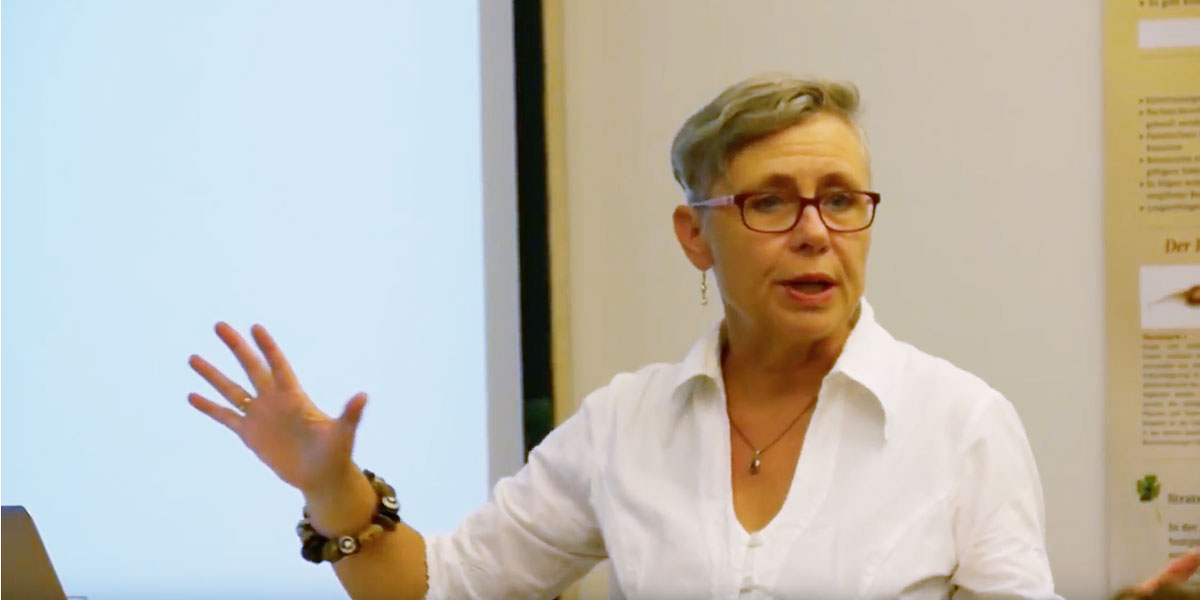
Half a century on from the first promises of wondercrops, GM has delivered little of value – and the same will be true of the new gene-edited GMOs, says researcher Dr Angelika Hilbeck
The GMO food venture is bound to fail because it is based on flawed scientific foundations. This was the message of a public talk given by Dr Angelika Hilbeck, researcher at ETH Zurich, Switzerland, and a board member and co-founder of the European Network of Scientists for Social and Environmental Responsibility (ENSSER), on the evening before the 9th GMO Free Europe conference in Berlin this September.
Dr Hilbeck's talk introduced a panel discussion with four other scientists: Prof Jack Heinemann of the University of Canterbury, New Zealand; Dr Ricarda Steinbrecher of Econexus; Dr Sarah Agapito-Tenfen of Genøk Centre for Biosafety, Norway; and Prof Ignacio Chapela of the University of California Berkeley. The entire discussion can be viewed here.
Below is our summary of Dr Hilbeck's talk, given from her perspective as an ecologist. This article will be followed by a second commentary on the same theme by the London-based molecular geneticist Dr Michael Antoniou, this time from the standpoint of molecular biology.
---
Agricultural genetic engineering is a promissory science that set itself up to fail from the get-go. In this talk I'm going to put forward the possible reasons for this. In doing so, I shall examine the scientific foundations of genetic engineering – something that scientists should have done when they started on the GMO venture 30-40 years ago when the tools were invented and we started engineering organisms – and put them forward for debate by known experts in this field.
The sky was supposedly the limit when it came to what you could do with these tools. But now, 20 years after the first commercial GMOs were introduced into agricultural and food system, GM has not delivered on its promises.
Now there is a new round of the same promises, this time based on the new "genome editing" scissors available. Will the new GM technology ever deliver on its promises?
The answer hinges on why it has not delivered with the old – but still widely used – techniques.
The first round of promises from genetic engineering advocates are now half a century old. They include:
* Abolition of hunger and malnutrition
* Higher yields
* Adaptations to changing climate
* Tolerance to diseases, pests, drought, salinity, aluminium toxicity, heat, cold
* Better nutritional value – vitamin A, iron fortification.
A four-step process to feed the poor
I took this image entitled "A four-step process to feed the poor", featuring GMO golden rice, from the website of the GMO industry body ISAAA.
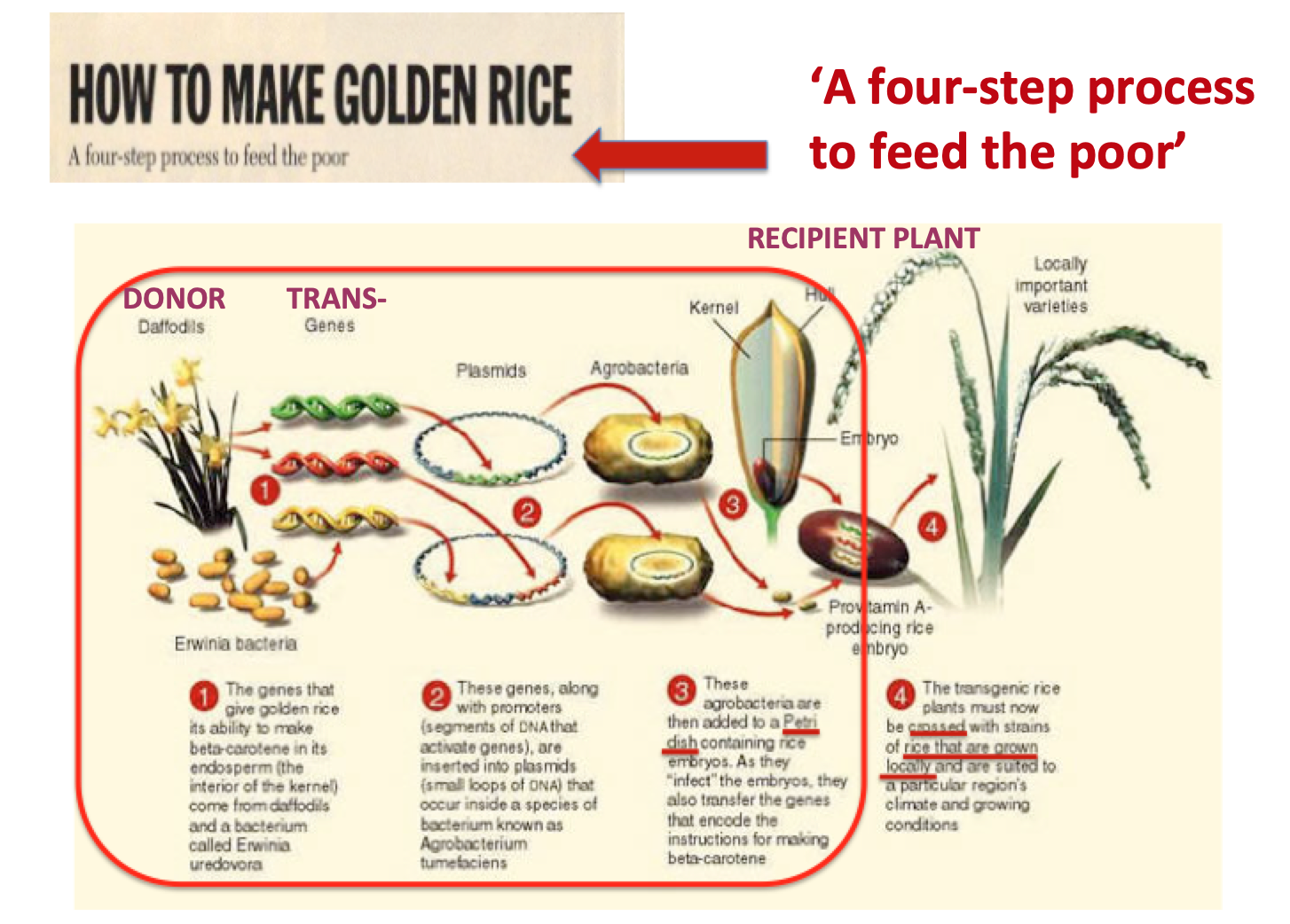
This is the same vision that underpins the making of any GMO. It was a four-step process not only to feed the poor but to feed anybody and most of it would take place in a petri dish in the laboratory.
The process would start by identifying a donor organism that you want to take the trait from and put it in another organism that is unrelated to the donor organism, which you wish to equip with this trait. So you have to identify the DNA sequence where you think this trait is coded, cut it out with the molecular scissors, put it on a shuttle (biolistic or Agrobacterium), and engineer it into the recipient plant.
Three of these four steps happen in the petri dish. Then there would be one further simple step – the fourth – of putting it into the chosen plant variety and growing it in the field. And then you would feed the poor, according to them.
The promises
These conceptual ideas had already gained currency in the early 1990s. These were the kinds of presentations that I saw at the university in the US where I did my PhD. The predictions were that we would be out of agronomic traits by the year 2000, and then in five-year leaps we would go into products for food processing, pharmaceuticals, and speciality chemicals by 2010. I heard many presentations in the US in which this was not even questioned. It was presented as "This is how it will be."
The agronomic traits would be herbicide resistance and insect resistance. We would then be leaping – why we would be leaping, I don't know, the scientific foundations of these five-year leaps have never been explained – into food processing traits, output traits, and consumer traits to give better foods, better oil composition, and starch composition. Then we would be going into pharmaceuticals or other kinds of industrial products, such as speciality chemicals.
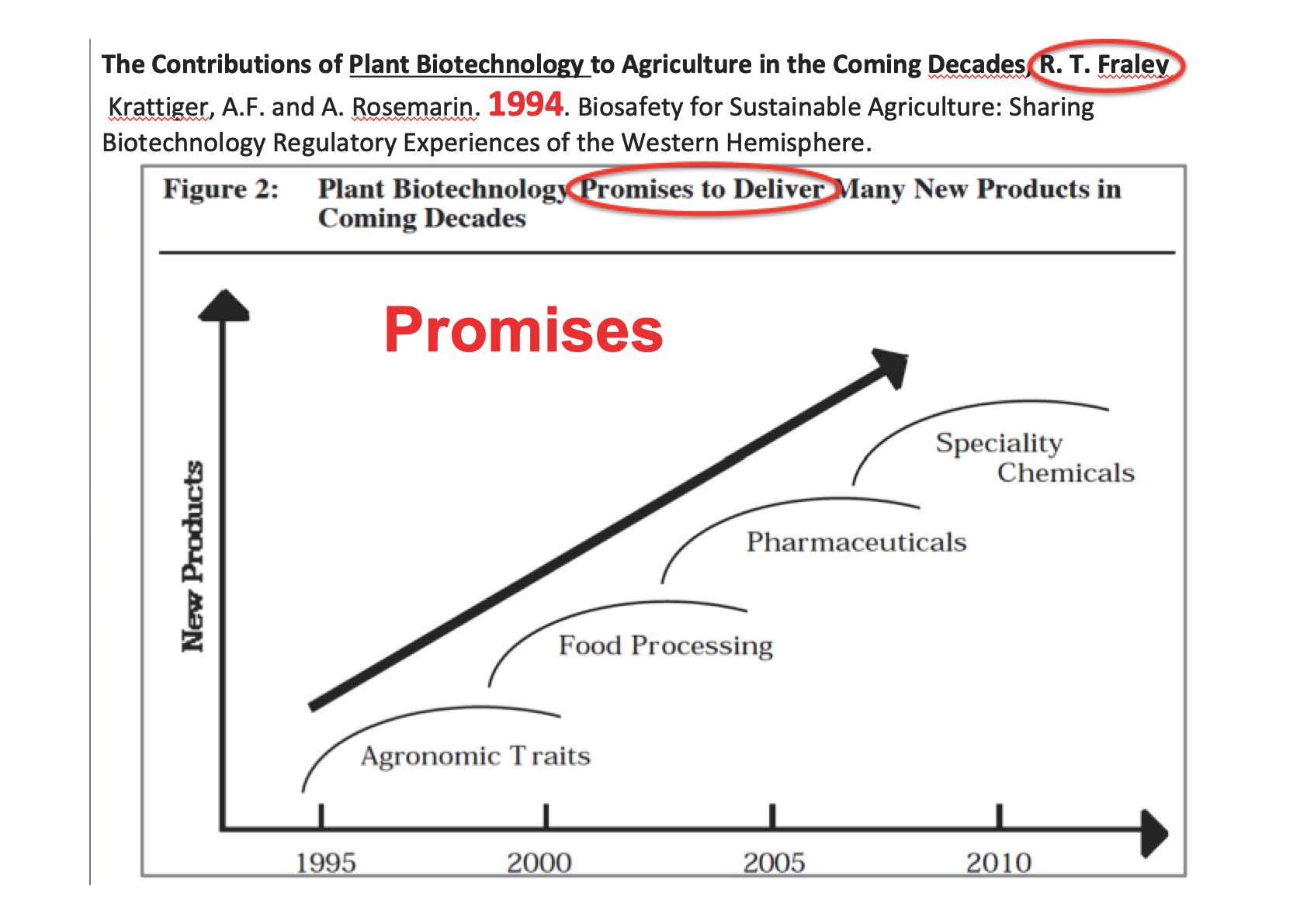
These were promises to deliver. It was not "Maybe, we try, perhaps it works." It was, "This is what we will be doing."
The reality
Now we are in 2018, way down the road from these promises. And the reality is that 99% of all GM crops grown in the field have only two traits: herbicide resistance (the majority to glyphosate-based herbicides) and insect resistance, with all of the latter based on traits taken from the bacterium Bacillus thuringiensis (Bt). What we see in terms of further innovation is that these two traits are simply being combined with one another, notably through conventional breeding, and less so through molecular stacking.
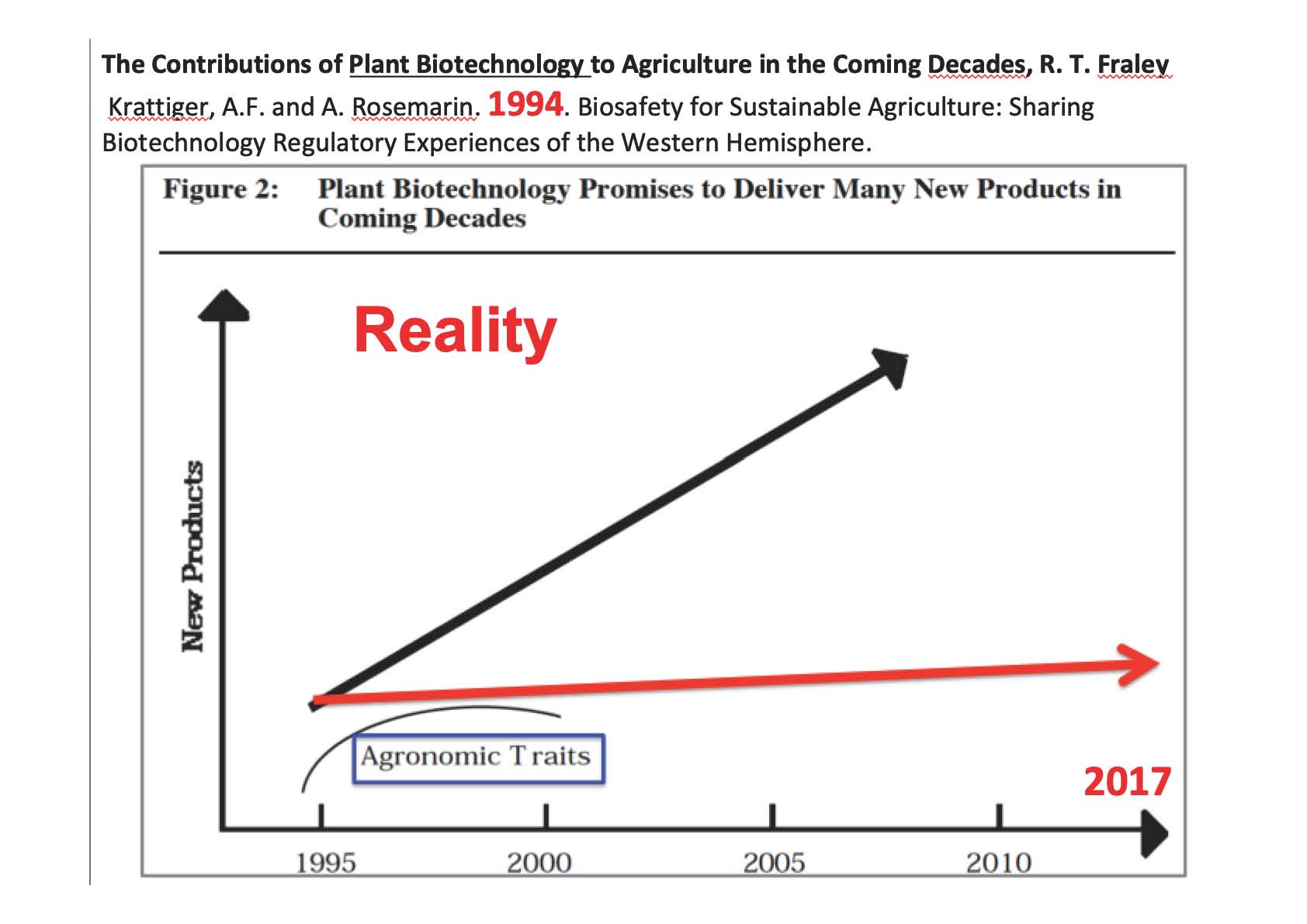
Golden rice still doesn't exist to this day, because that small step that was envisioned to introduce the "golden" trait into a variety popular with farmers has not worked. All attempts to put that golden trait into a rice variety that would be grown by farmers have so far failed. Golden rice proponents have not delivered plants that would be acceptable to farmers and would function in the market and production environment.
Higher yields were also promised. By 2009 we heard from the US, one of the heartlands of GM crops, that contrary to the myths about the superiority of GM crops, the yield gains that were observable were not due to the GMOs but to traditional breeding and improvements in the cultivation of these crops.[1]
In 2013 Prof Jack Heinemann and colleagues published a comparison of yield data submitted by governments annually to the FAO (Food and Agriculture Organisation), which showed how yields have fared in two comparable regions in terms of production, and access to the means of production, and where the only difference was that one region (North America) had adopted GMOs and the other region (Western Europe) had not. Yields continued to increase in both regions, but regions growing GM crops did not have a steeper increase. They didn't find much difference in yield for the crops that both regions were growing – in fact, there was an increasing trend since the introduction of GM crops for yields in non-GM-growing Europe to outstrip yields in North America, and to do so with lower pesticide use.[2]
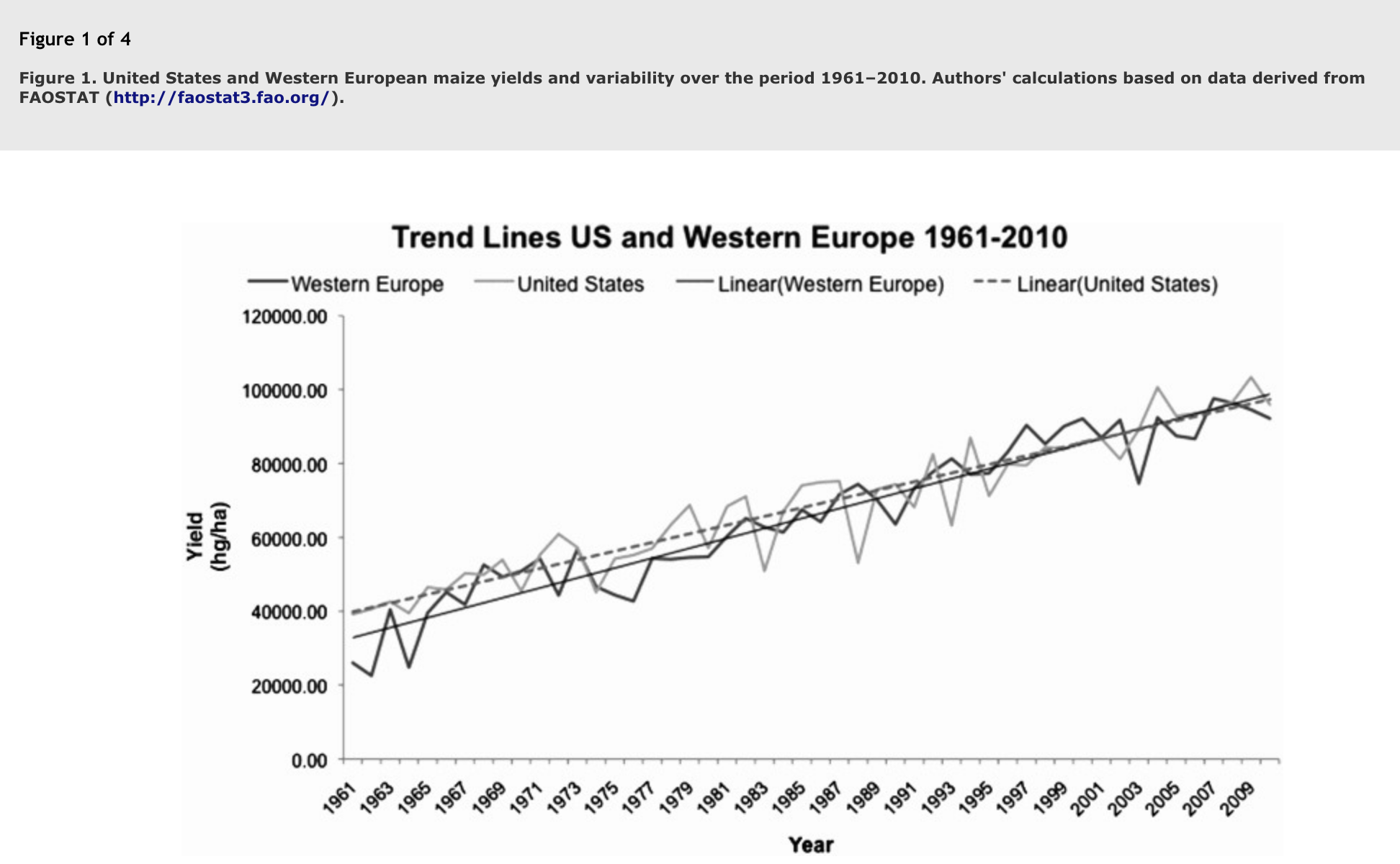
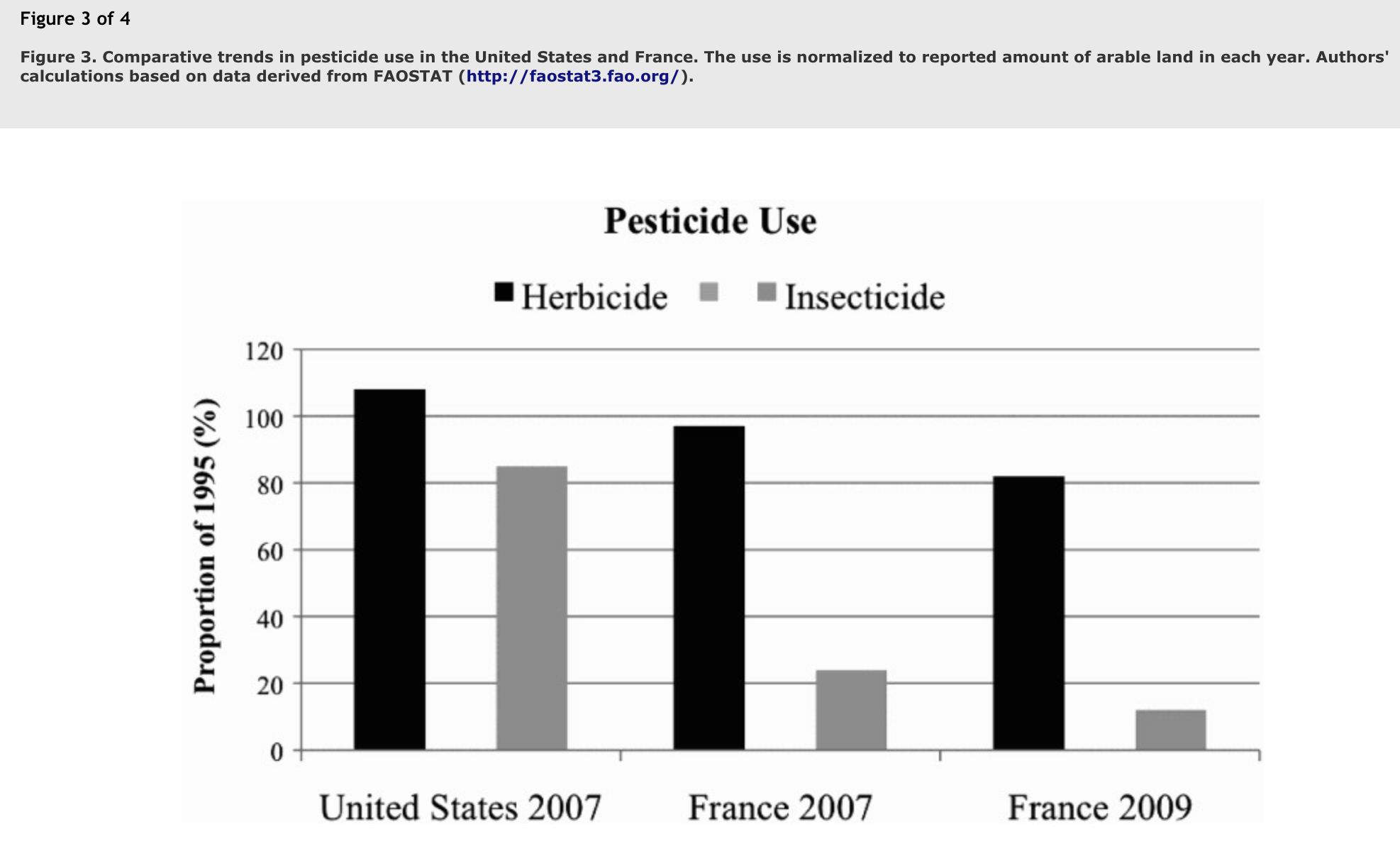
From Heinemann JA et al (2013). Sustainability and innovation in staple crop production in the US Midwest. International Journal of Agricultural Sustainability. 14 June. 71–88.
In 2016 the New York Times checked the data and found that nothing had changed since 2013 when Heinemann and colleagues published their paper. Yields continued to increase, but regions growing GM crops did not have a steeper increase in yields. Yield gains from GM were not delivered. So the NYT spoke of broken promises.[3]

It was the same with drought tolerant plants or plants adapted to other difficult environments. There is one GM crop out there today that Monsanto claims has a trait that improves yield protection under moderately water-limited conditions. They use very complicated phrasing, but if you look at the Web of Science you don't find independent peer-reviewed literature that has actually looked at whether or not that is true. So it is still unconfirmed. Interestingly, we hardly hear anything about this so-called drought-tolerant maize, even during these years of severe drought.
The same point was also made by the author of an article in Nature in 2014, who said that cross-breeding crops is actually delivering where GM is not.[4]
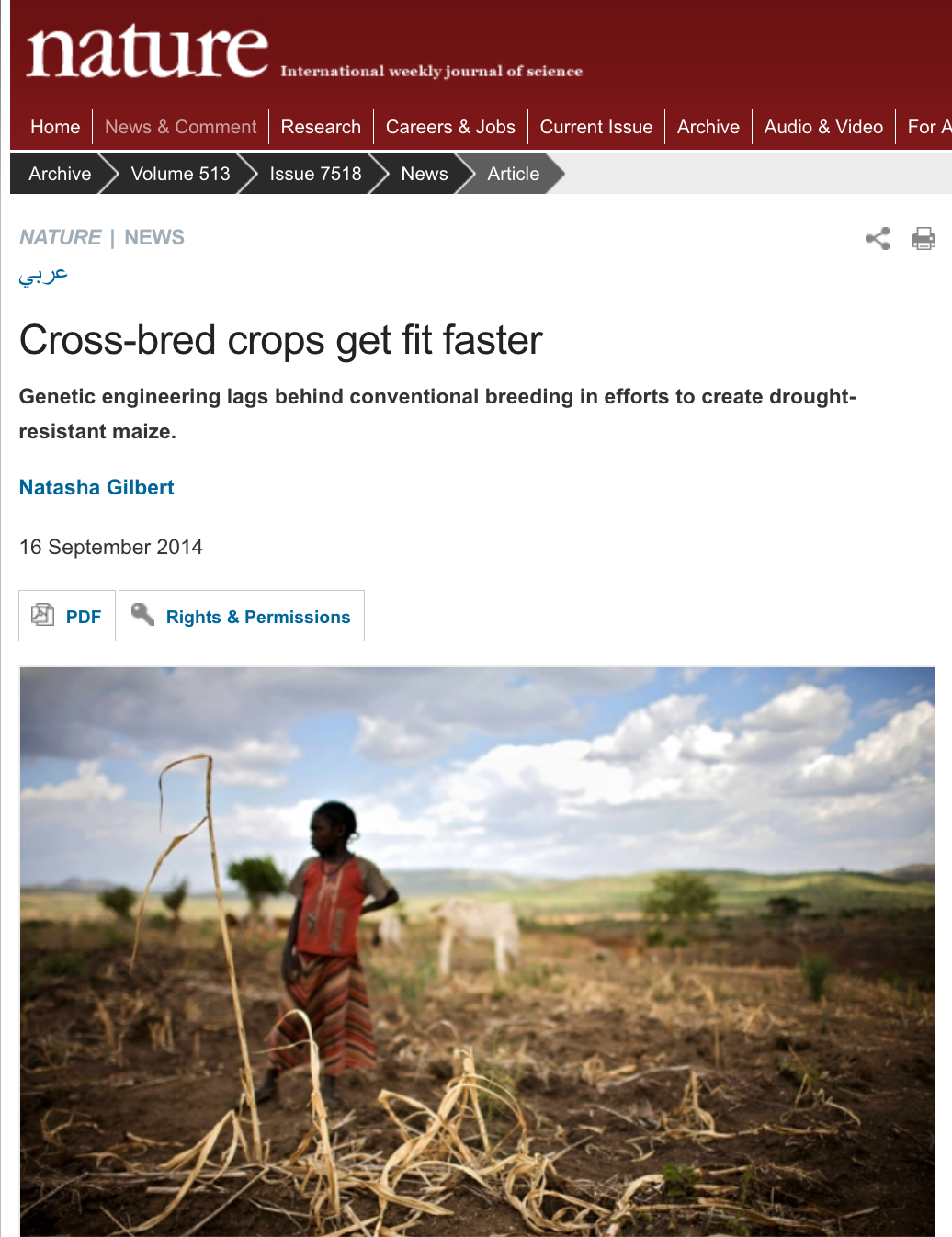
We do have drought-tolerant maize varieties – very good ones actually, I have worked with them – but they have been produced through conventional breeding, sometimes with the use of molecular breeding [the application of molecular biology tools such as gene mapping] or marker assisted breeding – not with GM.
So these promises, made two decades ago, have not materialised. For over 20 years we have been stuck in the agronomic trait phase. We must ask ourselves why.
Gene editing
Now there's a new kid on the block: so-called gene editing, which includes the CRISPR-Cas method. Instead of trying to work out why the first generation of genetic engineering tools hasn't delivered or worked, so that maybe there could be lessons to be learned for the next generation, they are now coming up with the same promises – but even bigger, if that is possible.
There is no critical debate or analysis – least of all of the scientific reasons why GM didn't deliver the first time.
In 2014, on the topic of CRISPR-Cas, a Newsweek article stated, "GMO scientists could save the world from hunger, if we let them". Really? Saving the world with point mutations? Again? Have we not learned from the last 20 years, when we tried that and it didn't work?
Regulations blamed
It hasn't escaped the agbiotech lobby that they haven't delivered. But their analysis of why that might be is somewhat different from mine. They put the blame squarely on regulations. Regulations are the obstacle and are blocking progress, they say. But in North and South America there is no regulation that would stop anything or anybody. North America boasts that they are “deregulating” GM plants without lengthy approval processes. So why haven't they delivered there?
A colleague from my university, Ingo Potrykus, also puts the blame squarely on the regulations, which, in his view, must be revolutionized.[5] He implies that unjustified and impractical legal requirements are stopping GM crops from saving millions from starvation and malnutrition.
Really? Or is it maybe because GM is based on outdated science?
Maybe they haven't done the right analysis and haven't learned what other fields in genetics have been finding over the years. When they discovered DNA as a material structure that carried the genetic information, they also promoted a dogma regarding its function and form. That dogma – genes make RNA molecules, which in turn make proteins – was not to be questioned. It was even called the “Central Dogma”. It also held the idea that information will only be passed on to the next generation if it is coded in DNA, in nucleotide sequences: nothing else will be passed on and the information will only go in one direction.
Digital biology
Others likened nucleotides to a digital code, so that you could use those four nucleotides to replace the binary code of the IT field. That was the hope. If that worked, it would be a quantum leap indeed. A paper from Nature in 2003 said that a remarkable feature of the structure of DNA is that it can accommodate almost any sequence of base pairs and hence convey any digital message or information. It said DNA has two types of digital information that you can manipulate, and then you can construct genes that encode proteins and genes that encode regulatory networks that determine the function of the genes. They claimed that the discovery of DNA was the start of a journey that would end in the grand unification of the biological sciences with the emerging information-based view of biology.
Well, 15 years have passed since these bold predictions were made, with nothing close to them materializing.
Life as construction kit
The vision is of life as a construction kit where you just replace binary code with the four digits of the DNA, and then these kinds of imaginaries will come true. You could build your own molecular computer, for example. Terminology like intentional biology [in which nature is seen as a source and code] and digital biology has emerged. These are fantasy fields resembling science fiction more than science – but they have been attracting huge amounts of money in the form of venture capital.
But there was one problem that they always ran up against. And those old papers make good reading to understand how they see the world. It's when they take these organisms – or the biochemical pathways that they generate in the lab – from the highly controlled, stable, and steady conditions of the lab out into the real world, where you have fluctuating conditions. Then the environment comes into play. They find this stochastic [random, unpredictable] information or events, depending on the environmental conditions. These events generate “noise” that ruins their signals and their idea – so they need to be attenuated. Hence, most of their energy goes into addressing how they can control this “noise” and these organisms and get the organisms to function like computers.
Epigenetics virtually ignored
What they’re missing is knowledge from other fields in science, for example, epigenetics. It means information passed on to the next generation that is not coded in the DNA. So that good old Central Dogma has been falsified, right there. Epigenetics shows that you can convey information to the next generation based on what you experience in your life. That is pretty revolutionary and fundamental. But astoundingly, it has not made much of an impression in the field of biotechnology. Why? A look at the history of these sciences gives a clue.
There's a timeline in which DNA was discovered, the Central Dogma created, and a narrative woven around it. Then scissors were discovered that enabled us to manipulate DNA and see what happens with the resulting organisms. And then came the big surprise in 2001 when it was discovered after sequencing the human genome that humans have fewer genes than most plants and we don't have more protein-coding genes than a tiny little nematode, for example. And nobody would claim that a tiny little nematode is as complex as a human or a human as simple as a nematode. So something wasn't quite working out; it didn't line up with how we had thought it should work until then.
Split in science
But instead of then going and inquiring further, the field split into two sectors. In the first were those who pushed for more and more genetic engineering – that's when all the above ideas came up in the early 2000s, right after the discovery of the human genome and the revelation that genetics did not work as we had thought, we saw the push for genetic engineering and an even more extreme arm of genetic engineering called synthetic biology, where it got more and more narrow. The second sector was the epigenetics field, which finally got the recognition it deserved.
Epigenetics is not a young science. Researchers had known for decades that the idea of the linear functioning of DNA didn't quite line up with other observations. But they were in a minority, they were marginalized and they weren't listened to. In the early 2000s their findings started to gain acceptance. And the field of genetics and evolution is getting broader and broader, to the point where today, even the concept of a gene is becoming blurred. Does the gene, as a discreet entity coded only in DNA, even exist?
The RNA world was discovered, the epigenetics world was discovered, and yet they didn't permeate through to the other applied technical sector of the science. There is a wall through which hardly anything passes. It became clearer and clearer in ecological genetics, for example, that traits like variability, plasticity, and adaptability of organisms are the key to survival and evolution. But on the other side of the wall, these survival traits became noise that had to be quenched and attenuated.
So I see a real schism in biology, with one sector indulging their fantasies of making life into machines – intentional digital biology – and the other saying, “I'm not even sure genes exist. I'm not even sure about a lot of things anymore that we thought we had figured out twenty years ago.”
Discussion needed
We need to open a discussion on the scientific limits to gene technology. As I see it, the questions that must be addressed are:
• How can we separate the science from the science fiction – which predictions can we solidly make – what does the science support? And at what point does it become more fiction than science?
• Has this whole endeavour of biotechnology become – with all the enormous funding that went into it – too big to fail? Perhaps we can no longer take that step back and critically reflect because the consequences of having to admit that we put our money into a bound-to-fail exercise are just too big to swallow?
• Should civil society build in these understandings of the scientific limits of gene technology before we start doing science fiction risk assessment of science fiction organisms – and if so, how?
Notes
1. Union of Concerned Scientists (2009). Failure to Yield. https://www.ucsusa.org/food_and_agriculture/our-failing-food-system/genetic-engineering/failure-to-yield.html#.W96xr6ecZ2Y
2. Heinemann JA et al (2013). Sustainability and innovation in staple crop production in the US Midwest. International Journal of Agricultural Sustainability. 14 June. 71–88.
3. Russell K and Hakim D (2016). Broken promises of genetically modified crops. New York Times. 29 Oct. https://www.nytimes.com/interactive/2016/10/30/business/gmo-crops-pesticides.html
4. Gilbert N (2014). Cross-bred crops get fit faster. Nature 513(7518). 16 Sept. https://www.nature.com/news/cross-bred-crops-get-fit-faster-1.15940
5. Potrykus I (2010). Regulation must be revolutionized. Nature 29;466(7306):561. doi: 10.1038/466561a
Dr Hilbeck’s talk and the subsequent panel discussion were organised by the European Network of Scientists for Social and Environmental Responsibility (ENSSER) in collaboration with GLS Bank, Zukunftsstiftung Landwirtschaft (Foundation for Future Agriculture) and Vereinigung Deutscher Wissenschaftler (Association of German Scientists).
Part 2 of this series of two articles is here: https://www.gmwatch.org/en/news/latest-news/18593










